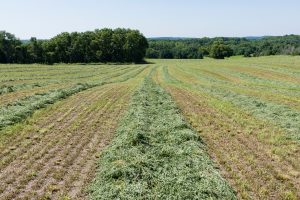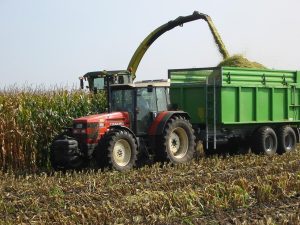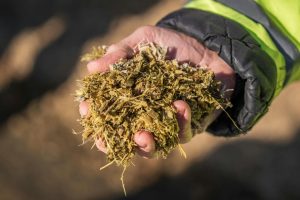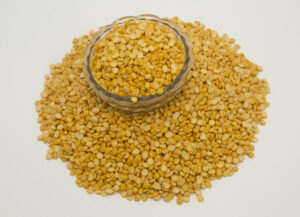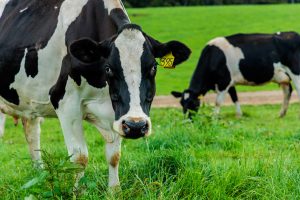Álvaro García
Corn silage is a very important forage in high-producing dairy herds due to its high energy density and digestibility. The starch content in corn silage contributes significantly to the total digestible nutrients (TDN) of dairy rations. However, the accessibility of starch to ruminal microbes and enzymatic digestion depends largely on how well the kernel is processed and how thoroughly its matrix, which is composed primarily of prolamins and the starch–protein matrix, is disrupted during ensiling. Recent innovations in silage inoculants, such as the inclusion of enzymes like α-amylase, have allowed to improve starch availability and overall feed efficiency.
Understanding amylase and its role in silage
Amylase is a type of enzyme that catalyzes the hydrolysis of starch into simpler sugars such as maltose and glucose. In the context of corn silage, α-amylase is the most relevant form, as it specifically cleaves the α-1,4-glycosidic bonds in amylose and amylopectin—the primary polysaccharides in plant starch. This enzymatic action makes starch more digestible and fermentable for dairy cows.
When included in silage inoculants, α-amylase can begin breaking down starch molecules during the ensiling process, even before the silage is consumed. This early hydrolysis increases the availability of fermentable carbohydrates to rumen microbes, enhancing microbial protein synthesis and the production of volatile fatty acids (VFAs), especially propionate, a key precursor for glucose in ruminants. These effects can translate into higher milk yields and improved feed efficiency, as cows utilize nutrients more effectively without necessarily increasing dry matter intake.
A 2025 study by Silva et al., published in the Journal of Dairy Science, investigated the impact of feeding silages treated with α-amylase–enabled corn grain. The experiment involved 60 lactating Holstein cows fed total mixed rations (TMR) in which 5% or 10% of the dietary dry matter came from corn silage pretreated with α-amylase. The results were very revealing:
- Cows fed diets with 10% amylase-treated corn grain produced more milk (45.3 kg/day or 99.9 lbs./day) than those fed untreated silage (43.9 kg/day or 96.8 lbs./day).
- Dry matter intake remained unchanged across treatments, which means there was better nutrient efficiency rather than increased feed intake.
- Milk protein content and energy-corrected milk output trended higher in the amylase group, which suggests enhanced nutrient utilization.
The study suggests that α-amylase not only enhances starch breakdown during fermentation but also continues to benefit the animal post-ingestion. Partially hydrolyzed starch likely becomes more accessible in the rumen, supporting faster colonization by amylolytic bacteria and improved digestion kinetics. These combined effects reinforce the value of using amylase-based inoculants in dairy nutrition aimed at maximizing milk production without increasing feed costs.
Mechanisms of action and practical applications of amylase in silage
While the hydrolysis of starch into fermentable sugars is the primary and most visible function of α-amylase in corn silage, its impact extends beyond simple carbohydrate breakdown. One important secondary mechanism is its influence on silage fermentation dynamics. When amylase acts on starch during the early phases of ensiling, it releases sugars that become readily available substrates for lactic acid bacteria (LAB), like Lactiplantibacillus plantarum. These bacteria need simple sugars, producing lactic acid more rapidly, which in turn causes the silage pH to drop more quickly. This accelerated acidification helps stabilize the silage early, reducing spoilage, inhibiting undesirable microbes, and protecting protein from degradation.
Additionally, research has shown that enzyme-treated silages tend to have lower residual starch in cow feces, suggesting an improvement in their total tract digestibility. This is particularly important in high-starch rations where the limiting factor in starch utilization is often not intake but the ability of the rumen and hindgut to digest and absorb the nutrients efficiently. By enhancing the extent of starch hydrolysis before and during fermentation, α-amylase facilitates more complete digestion, reducing nutrient loss and increasing feed conversion efficiency.
These benefits are being applied in commercial silage inoculants, such as Dellait’s Nutretain line—ONE, PLUS, and MAX. These inoculants combine α-amylase with targeted bacterial strains like Lactiplantibacillus plantarum and Pediococcus pentosaceus, selected for their efficacy in promoting rapid fermentation and reducing spoilage.
The fiber-degrading enzymes added to these inoculants complement the bacterial action: while the bacteria ferment sugars into lactic acid to reduce pH and preserve the forage, the enzymes break down polysaccharides like starch, making these sugars more available. This synergistic relationship between enzymes and bacteria enhances not only the preservation of silage but also its digestibility and nutritional value for the cow.
From a production standpoint, the inclusion of amylase in silage inoculants can offer substantial economic advantages. One of the most important is the improvement of income over feed costs. Corn grain is an expensive component of dairy cow rations, so improving its utilization efficiency pays off. Even a modest increase in milk yield like the 1.4 kg/day from the experiment by Silva et al. reported above, could yield an additional $0.75 to $1.00/day per cow, depending on prevailing milk prices. Improved digestibility also contributes to better rumen health by reducing undigested starch reaching the hindgut, where it can cause acidosis or other metabolic disturbances.
Important silage management factors
To be able to realize the full benefits of amylase-treated silage requires attention to key management factors:
- Kernel Processing Score (KPS): The effectiveness of amylase depends heavily on kernel breakage during harvest. A KPS above 70% ensures that starch granules are accessible to enzymatic action. Poorly processed kernels may protect starch from hydrolysis, limiting the benefits of amylase.
- Chop Length and Packing Density: Proper chop length ensures uniform distribution of forage and enzymes, while tight packing reduces oxygen infiltration, promoting anaerobic fermentation conditions. This supports both microbial growth and enzyme function.
- Silage Moisture Content: Maintaining optimal moisture levels (typically 65–70%) is critical. If silage is too dry, microbial activity slows down, and enzymes may not function effectively. Conversely, overly wet silage risks seepage and clostridial fermentation.
Amylase-based silage inoculants not only improve starch availability during fermentation but also have far-reaching benefits in terms of rumen function, nutrient absorption, animal performance, and environmental impact. When used correctly, they represent a strategic nutritional tool to maximize returns on feed investments.
From a sustainability standpoint, the use of amylase in silage can contribute to lower methane emissions per unit of milk. Improved starch digestion in the rumen shifts fermentation toward propionate production, a hydrogen sink, reducing hydrogen availability for methane synthesis.
Amylase-enriched inoculants offer a promising approach to enhance starch availability, improve silage fermentation, and boost animal performance. Backed by recent research and practical on-farm results, the inclusion of α-amylase in corn silage inoculants represents a scientifically validated, economically viable, and environmentally beneficial strategy for modern dairy operations. As feed prices continue to rise and efficiency becomes essential, technologies that increase nutrient utilization—such as enzyme-enhanced silage—will play an increasingly vital role in the profitability and sustainability of livestock farms.
The full list of references used in this article is available upon request.
© 2025 Dellait Knowledge Center. All Rights Reserved.


